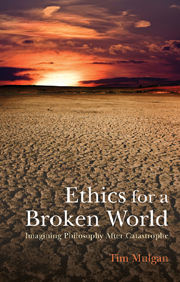Preface: Imagining a broken world
Summary
This book asks how the central themes and quesitions of political philosophy might change if we were living in a broken world: a place where resources are insufficient to meet everyone's basic needs, where a chaotic climate makes life precarious and where each generation is worse off than the last. To make that thought experiment vivid, I imagine a history of philosophy class in the broken world, studying classic texts from a past age of affluence in the early twenty-first century. Apart from this Preface and the Reading List, the book consists of transcripts from that imaginary future class.
Climate change is a topical issue, and the broken world is one possible future. However, this book is not primarily about climate change. The device of the broken world serves instead to highlight the contingency of our moral and political ideals, asking us to see our society and its ideals from the outside. Reimagining contemporary philosophy for a broken world offers the same benefits as studying past political philosophers in their historical context.
At times, I do touch indirectly on what moral and political philosophy might have to say about climate change. And I do hope that reflecting on how our descendants will see their world, and how they might view our legacy, may lead us to rethink our way of life.
- Type
- Chapter
- Information
- Ethics for a Broken WorldImagining Philosophy after Catastrophe, pp. ix - xiiPublisher: Acumen PublishingPrint publication year: 2011
- 1
- Cited by



